Background:
Bench testing results of the Unitronic, AMS Performance, and most recently Forge Motorsport intercoolers raised some questions, as well as statements, about the testing method.
One particularly broad statement was “This is good and all, but has little basis in reality.”
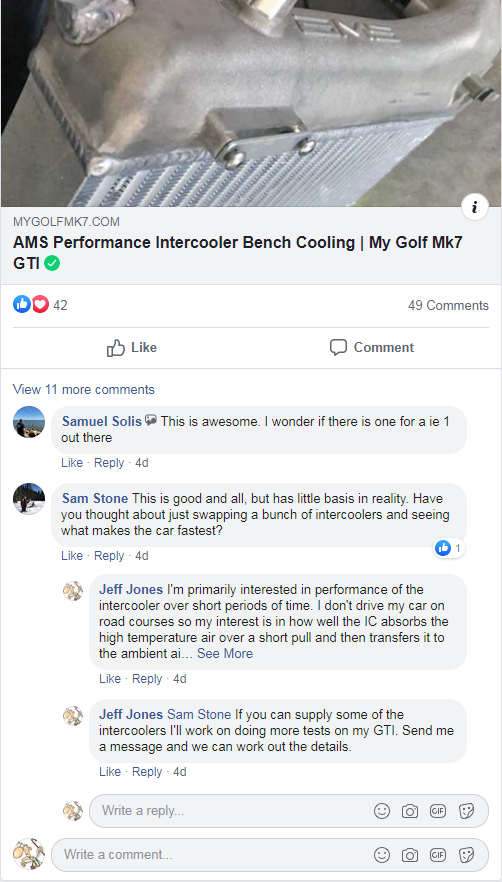
I provided the contributor with some reasons for the method being used in the bench test and asked him to contact me. He never did contact me so I decided to reference Sam’s comments to discuss a few points about the intercooler bench testing, and testing in general, to explain the reasons for this particular test method and try to clear up misunderstanding other people might also have.
Intercooler / Heat Exchanger
The product being tested during the bench cooling test is an intercooler, a particular type of crossflow heat exchanger. The purpose of the device is to transfer heat between two fluids (air in this case) at different temperatures separated by a solid barrier. Hot air from the turbocharger passes through the intercooler and transfers heat into the intercooler core by convection. Then conductive heat transfer occurs through the charge row walls to the core fins, and then finally the heat is removed from the core fins by convection with the surrounding air.
The goal of using an intercooler is to remove a maximum amount of heat from the charge air so that cooler, denser air, exits the part.
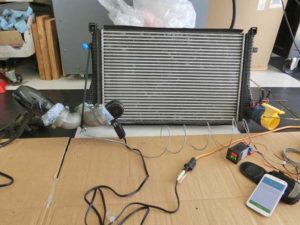
The bench test simulates the heat transfer process of hot air flowing into the intercooler and the heat being transferred out into the surrounding ambient air, so that cooler air exits the intercooler, but under different conditions than occur on the vehicle.
For the bench test a pair of hot air sources flow heated air through the intercooler continuously. The core fins are exposed to the atmosphere to allow heat to exit the core. At a predetermined time air surrounding the intercooler is pushed through the core by a fan to increase the rate of heat transfer from the intercooler.
Understanding the function and mechanism of a cross flow heat exchanger (intercooler) along with how the test simulates the heat transfer process, I don’t believe there is a valid basis for the statement questioning the “reality” of the test.
Driving Simulation
Perhaps “little basis in reality” was an effort to say the test does not simulate an operating automobile? While that is not the purpose for the test, I looked for a situation during driving that mimicked the bench cooling test.
I was able to find a recent datalog that shows a situation similar to that of the bench cooling test.
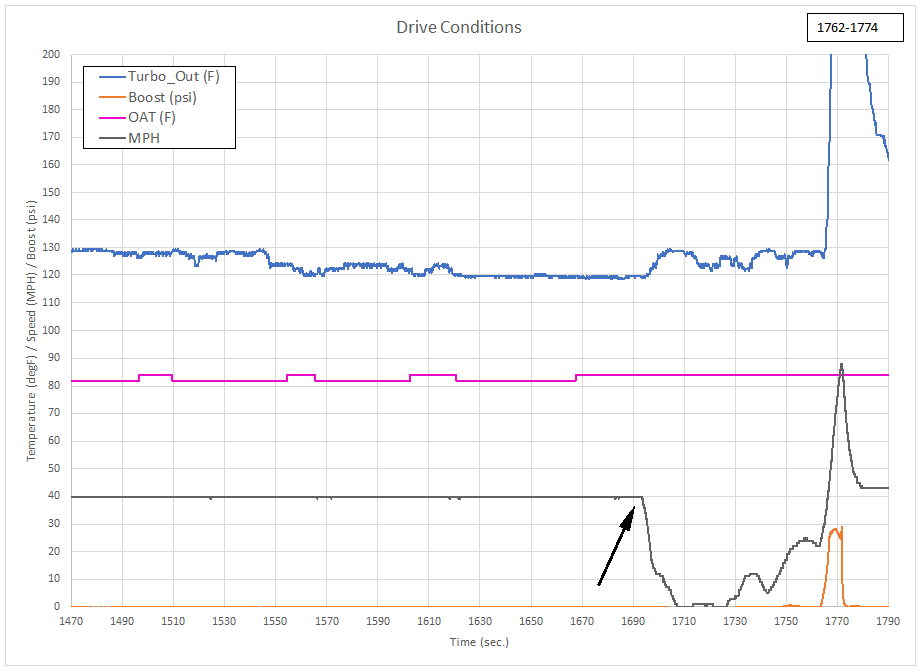
Shown on this chart the GTI is cruising at 40 mph. Outside air temperature is around 82F and the temperature exiting the turbocharger is between 120-130F. No boost pressure is being generated while cruising.
At approximately time 1690 the vehicle slows down and stops. No longer is air being pushed through the intercooler by the vehicle forward motion while the turbocharger continues to supply heated air to the intercooler at temperatures between 120-130F. After being stationary for approximately 20 seconds the vehicle begins to move again, once more creating air movement across the intercooler core.
This situation was found to occur several times during the drive. In this next example the air temperature exiting the intercooler has been added to the chart.
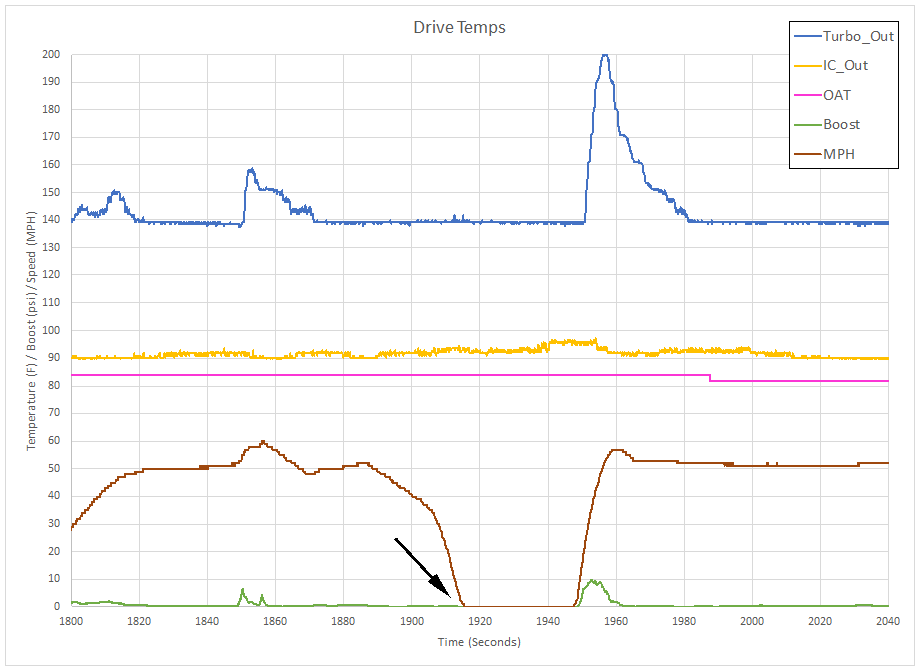
The vehicle is traveling at roughly 50 mph with an outside air temperature around 83F and the temperature exiting the turbocharger roughly 140F with no boost being generated. The temperature exiting the intercooler is around 90F.
Around time 1915, illustrated with the arrow, the vehicle slows to a stop. The air movement through the intercooler caused by the vehicle’s forward motion ceases. The car is stationary for approximately 40 seconds during which time the air temperature out of the turbocharger remains 140F and the temperature out of the intercooler increases slightly to around 95F. Around time 1925 the vehicle accelerates moderately quickly, increasing the air temperature out of the turbocharger, while also increasing airflow across the intercooler.
To recap the situations shown in these two examples:
- The intercooler has heated air being passed through it while being exposed to forced cooling air.
- The vehicle stops moving, reducing the cooling air across the core with no change in the temperature of the air passing through the inside of the intercooler.
- The vehicle begins to move again resupplying forced cooling air to the intercooler core.
While the bench test is not intended to replicate any particular operating situation, periods 2 and 3 of the above scenarios are similar to the bench cooling test phases of heating the core absent forced cooling, and then heating the core in the presence of forced cooling.
The two driving scenarios shown above were not hard to find in data logs that I have recorded during routine driving. Stopping for traffic control devices is a common occurrence for me and because of that the bench cooling test is relevant to how I operate the vehicle.
Understanding the similarities between the driving situation and phases of the bench cooling test I don’t believe there is a valid basis for the statement questioning the “reality” of the test.
Test Topic, Conduct, and Criteria
The last point is about testing.
Previously I’ve addressed differences in test objectives and why they matter. The bench cooling test has a specific purpose and it is not to attempt to replicate the conditions on the vehicle. The bench test is being conducted to improve the likelihood of conducting a successful test on the GTI.
Sam did not continue to discuss his concern about the test so there have been no suggestions for possible ways to improve the test, or to clear misunderstanding Sam may have about the test purpose and limitations.
It’s no surprise that comments from the peanut gallery comprise a large portion of any discussion on a Facebook group. In this instance, if Sam is who his profile says he is, it might have been worthwhile for him to stick around longer and help the group.

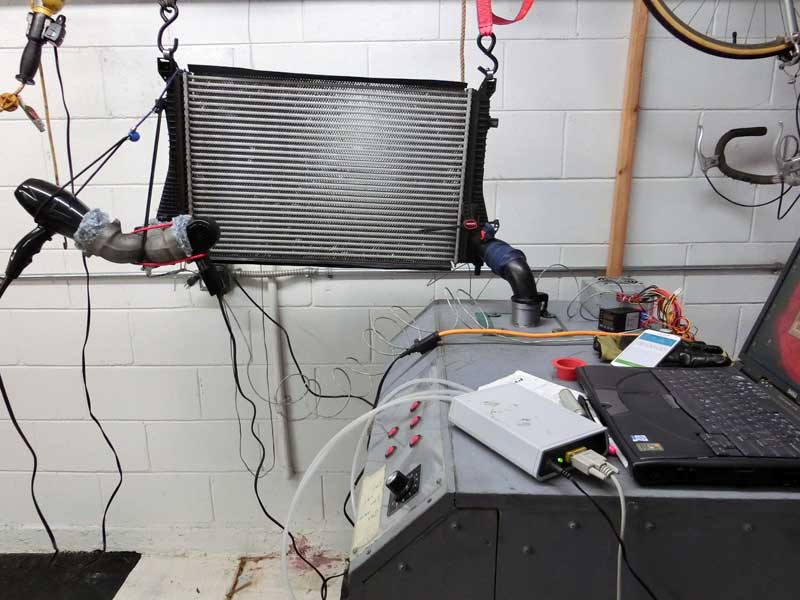

thanks for all your efforts here this data is useful regardless of what peoples emotional opinions are. people always want to believe they made the best choice and that their part is best and do not like it when unbiased data makes their expensive purchase seem useless.
The challenge as I see it w/r to testing ICs “in the real world” is simply controlling all of the variables. Ideally, you have constant enviro conditions and you swap ICs in/out (huge amount of work) of the car and log ambient to IAT difference over a controlled set of driving conditions and the IC that has the lowest overall average ambient to IAT difference is the winner.
I agree. The number of conditions that can be controlled goes down and the best that can be done is to record conditions and try to correlate results after gathering data. It’s possible to try and create conditions that are close from one run to the next, but that narrows the window of opportunity for testing when the environment comes into play. Doing more test runs helps to give more data that can be aggregated, but doing a lot of test runs presents problems. Even once I start gathering data on the car it will be of limited use, I plan on third gear pulls, which isn’t going to be particularly helpful to the person interested in quarter mile drag runs, or the person who does Autocross, or the person who drives road courses.